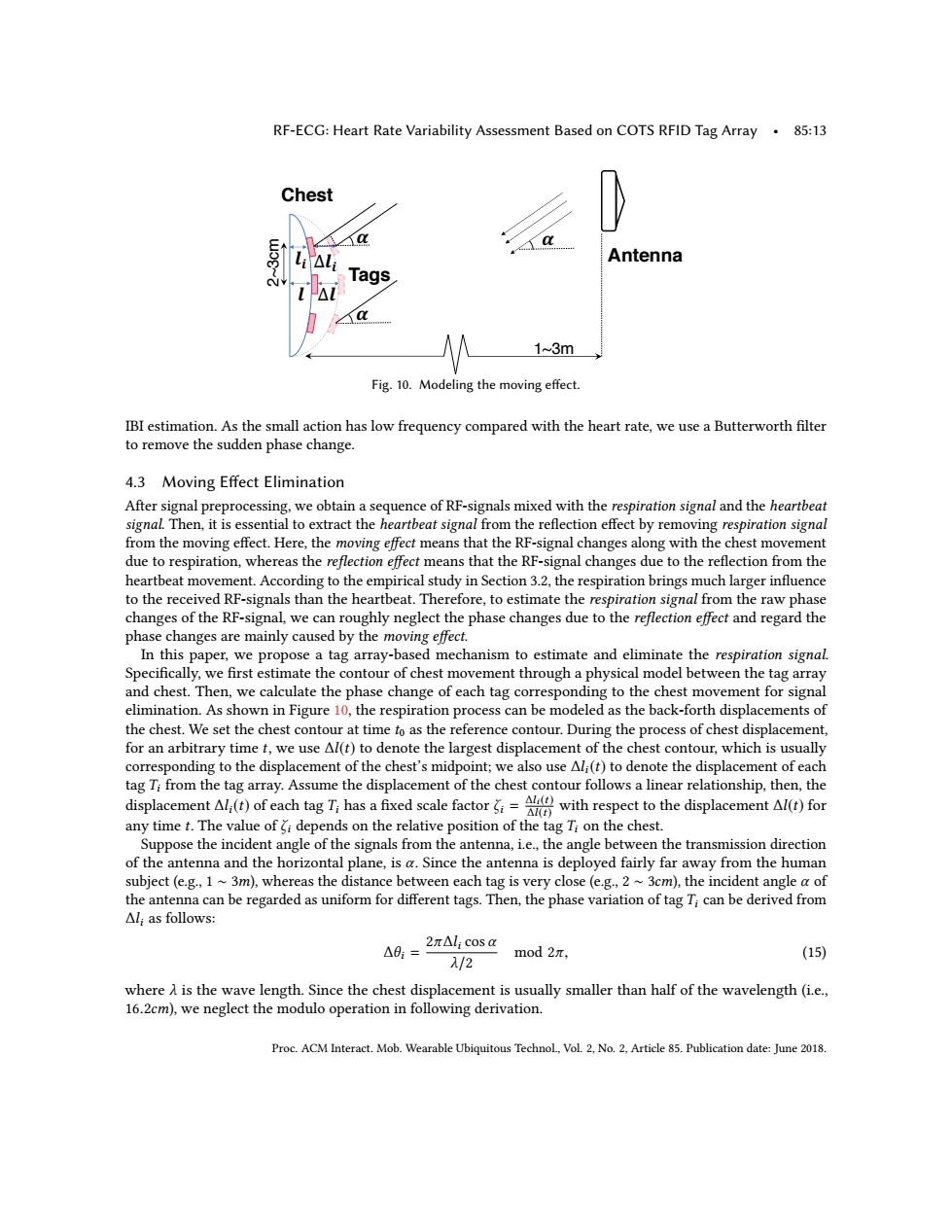正在加载图片...

RF-ECG:Heart Rate Variability Assessment Based on COTS RFID Tag Array.85:13 Chest △ Antenna Tags 13m Fig.10.Modeling the moving effect. IBI estimation.As the small action has low frequency compared with the heart rate,we use a Butterworth filter to remove the sudden phase change. 4.3 Moving Effect Elimination After signal preprocessing.we obtain a sequence of RF-signals mixed with the respiration signal and the heartbeat signal.Then,it is essential to extract the heartbeat signal from the reflection effect by removing respiration signal from the moving effect.Here,the moving effect means that the RF-signal changes along with the chest movement due to respiration,whereas the reflection effect means that the RF-signal changes due to the reflection from the heartbeat movement.According to the empirical study in Section 3.2,the respiration brings much larger influence to the received RF-signals than the heartbeat.Therefore,to estimate the respiration signal from the raw phase changes of the RF-signal,we can roughly neglect the phase changes due to the reflection effect and regard the phase changes are mainly caused by the moving effect. In this paper,we propose a tag array-based mechanism to estimate and eliminate the respiration signal Specifically,we first estimate the contour of chest movement through a physical model between the tag array and chest.Then,we calculate the phase change of each tag corresponding to the chest movement for signal elimination.As shown in Figure 10,the respiration process can be modeled as the back-forth displacements of the chest.We set the chest contour at time to as the reference contour.During the process of chest displacement. for an arbitrary time t,we use Al(t)to denote the largest displacement of the chest contour,which is usually corresponding to the displacement of the chest's midpoint;we also use Ali(t)to denote the displacement of each tag Ti from the tag array.Assume the displacement of the chest contour follows a linear relationship,then,the displacement Al (t)of each tag Thas a fixed scale factorwith respect to the displacement Al(t)for any time t.The value of i depends on the relative position of the tag Ti on the chest. Suppose the incident angle of the signals from the antenna,i.e.,the angle between the transmission direction of the antenna and the horizontal plane,is a.Since the antenna is deployed fairly far away from the human subject (e.g.,1~3m),whereas the distance between each tag is very close(e.g.,2~3cm),the incident angle a of the antenna can be regarded as uniform for different tags.Then,the phase variation of tag Ti can be derived from △I;as follows: A0,=27Al;cos a mod2π, (15) λ/2 where A is the wave length.Since the chest displacement is usually smaller than half of the wavelength(i.e., 16.2cm),we neglect the modulo operation in following derivation. Proc.ACM Interact.Mob.Wearable Ubiquitous Technol,Vol.2,No.2,Article 85.Publication date:June 2018.RF-ECG: Heart Rate Variability Assessment Based on COTS RFID Tag Array • 85:13 ! "# "#$ ! # #$ ! Chest 2~3cm 1~3m Antenna Tags Fig. 10. Modeling the moving effect. IBI estimation. As the small action has low frequency compared with the heart rate, we use a Butterworth filter to remove the sudden phase change. 4.3 Moving Effect Elimination After signal preprocessing, we obtain a sequence of RF-signals mixed with the respiration signal and the heartbeat signal. Then, it is essential to extract the heartbeat signal from the reflection effect by removing respiration signal from the moving effect. Here, the moving effect means that the RF-signal changes along with the chest movement due to respiration, whereas the reflection effect means that the RF-signal changes due to the reflection from the heartbeat movement. According to the empirical study in Section 3.2, the respiration brings much larger influence to the received RF-signals than the heartbeat. Therefore, to estimate the respiration signal from the raw phase changes of the RF-signal, we can roughly neglect the phase changes due to the reflection effect and regard the phase changes are mainly caused by the moving effect. In this paper, we propose a tag array-based mechanism to estimate and eliminate the respiration signal. Specifically, we first estimate the contour of chest movement through a physical model between the tag array and chest. Then, we calculate the phase change of each tag corresponding to the chest movement for signal elimination. As shown in Figure 10, the respiration process can be modeled as the back-forth displacements of the chest. We set the chest contour at time t0 as the reference contour. During the process of chest displacement, for an arbitrary time t, we use ∆l(t) to denote the largest displacement of the chest contour, which is usually corresponding to the displacement of the chest’s midpoint; we also use ∆li(t) to denote the displacement of each tag Ti from the tag array. Assume the displacement of the chest contour follows a linear relationship, then, the displacement ∆li(t) of each tag Ti has a fixed scale factor ζi = ∆li (t) ∆l(t) with respect to the displacement ∆l(t) for any time t. The value of ζi depends on the relative position of the tag Ti on the chest. Suppose the incident angle of the signals from the antenna, i.e., the angle between the transmission direction of the antenna and the horizontal plane, is α. Since the antenna is deployed fairly far away from the human subject (e.g., 1 ∼ 3m), whereas the distance between each tag is very close (e.g., 2 ∼ 3cm), the incident angle α of the antenna can be regarded as uniform for different tags. Then, the phase variation of tag Ti can be derived from ∆li as follows: ∆θi = 2π∆li cos α λ/2 mod 2π, (15) where λ is the wave length. Since the chest displacement is usually smaller than half of the wavelength (i.e., 16.2cm), we neglect the modulo operation in following derivation. Proc. ACM Interact. Mob. Wearable Ubiquitous Technol., Vol. 2, No. 2, Article 85. Publication date: June 2018